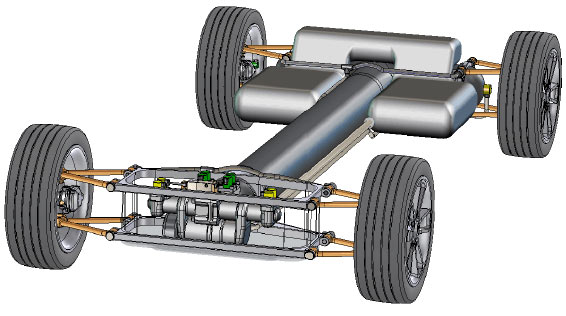The piston of the free-piston internal combustion engine pumps hydraulic fluid into the accumulator. It stores the energy by compressing the gas bladder inside. The engine will be turned off automatically when the accumulator is filled – and turned on again shortly before it becomes empty.
The pressurized fluid drives the wheelmotors, one in each wheel. Their driving power is continuously variable from zero to maximum speed.
The wheelmotors are reversed during braking and become pumps. They are powerful enough to stop the car like disk brakes, while recuperating the entire braking energy. The energy is stored in the accumulator and used again for driving. The ‘round-trip-efficiency’ during braking is 70% to 85%. The energy is stored in the accumulator and will be used again to drive the car."
To increase the overall fuel consumption, the losses within the powertrain and those from braking have to be significantly lowered. Both losses are considerably reduced by separating the operating profile of the engine from that of the car. This is made possible by the accumulator, acting as buffer between both operational requirements. The functioning is here obtained by:
d. Constant operating conditions for the engine.
Independent from the power needs of the wheelmotors, the engine charges the accumulator under full power and only for a short period of time. Here, the engine operates under its best possible operating conditions of constant pressure and speed to minimize fuel consumption and emissions.
In addition, the free-piston engine has inherently fewer losses and is significantly lighter, reducing the weight of the car. Best current engines have a specific fuel consumption of 0.310 lb/hp·h but operate at an average of 0.450 lb/hp·h. A consumption of 0.284 lb/hp·h (175 gr/kW·h) has been used in the calculation.
e. Recuperation of the entire braking energy.
Braking consumes a large part of the energy, about 40% during city driving of the NEDC. This is twice as much as energy used for driving at constant speed. The recuperation of this energy with a high ‘round-trip-efficiency’ reduces the consumption considerably.
The high power peaks during braking require very powerful drive motors to recuperate the large amounts of energy. Motors which are large enough to accelerate the light car (e.g. 200 hp) are too small to recuperate the entire braking energy (600 hp).
The calculation of fuel consumption is based on the 130 MPG CAR driving the NEDC Cycle. (New European Driving Cycle). This, as other standardized driving cycles, does not reflect a typical driving pattern. The effectiveness of the Hydrostatic Powertrain improves under more realistic conditions.
The fuel consumption for constant speeds is:
110 mpg @ 60 mph
170 mpg @ 30 mph

